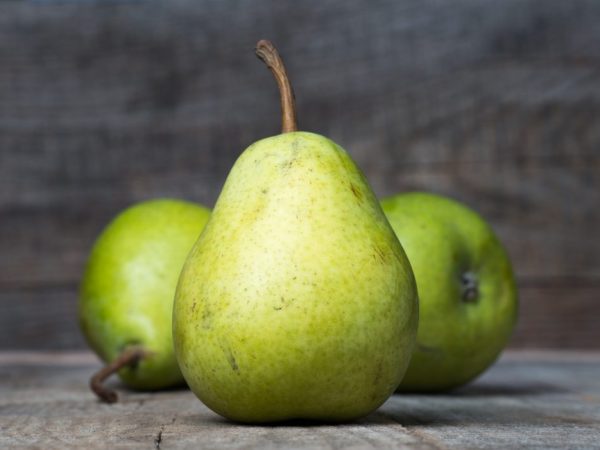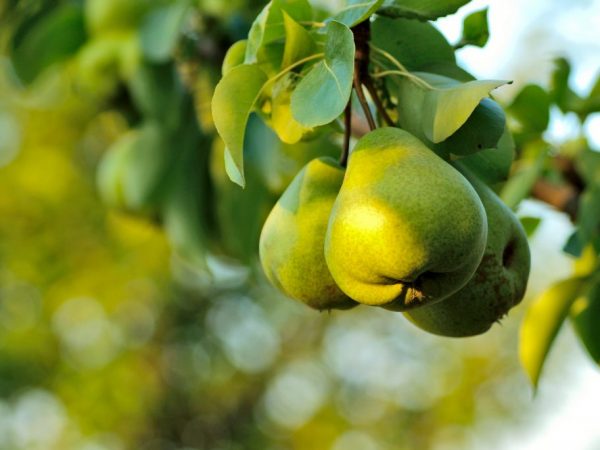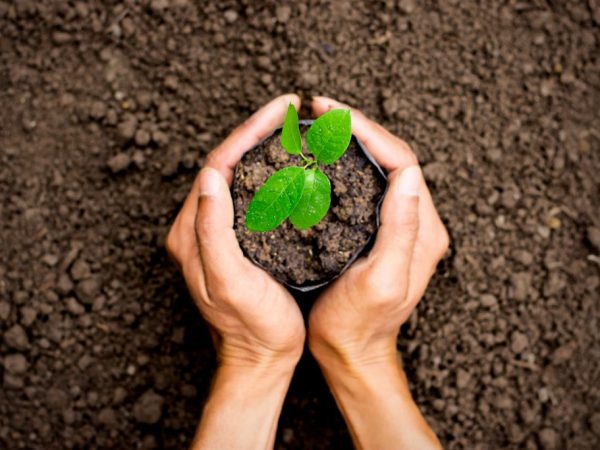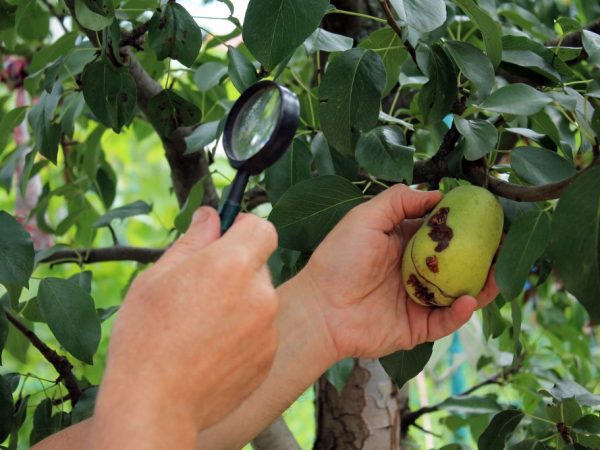Characteristics of the pear variety Augustowskaya Rosa
Pear Augustow Dew is a hybrid of the Tenderness variety and the Australian Triumph Pakgama variety. This wonderful variety was bred by the famous scientist S.P. Yakovlev at the All-Russian Research Institute of Genetics and Selection of Fruit Plants. The pear variety Avgustovskaya Rosa is endowed with such qualities of the Tenderness variety as frost resistance and disease resistance. As well as high-yielding and quick fruiting of the Triumph Pakgama variety.

Characteristics of the pear variety Augustowskaya Rosa
Structural features
Dew trees grow low up to 3 m in height. The culture is fast growing. The crown is not very dense, the shape is slightly drooping. The smooth bark has a rich gray color.
Pear Augustowskaya Dew forms many buds and shoots. Light brown shoots, quite massive and grows almost perpendicular to the trunk. They are covered with numerous small lenticels. The kidneys are small, bent, narrowed upwards.
The dark green leaves of the Augustovskaya Dew pear are oval, small, slightly pointed at the end.
The flowers are small, white, and shaped like saucers.
The culture is self-pollinating, but weak. Therefore, the August Dew must be planted next to pollinators. The Pamyati Yakovlev variety was recognized as the best of them.
Fruiting of August Dew begins at the 4th year. The harvest is plentiful - about 10 kg of fruit can be harvested from one tree. Maturation occurs at the end of summer.
Description of the variety Avgustovskaya Rosa
Avgustovskaya Dew is a summer pear variety. But depending on the region of cultivation, ripening can occur at the beginning of autumn. August Dew is a pear, the description of which is presented by many advantages:
- small crown size;
- early fruiting;
- high and stable yield;
- resistance to cold climates;
- scab resistance;
- ease of growing;
- one-dimensionality of fruits;
- the level of marketability is about 90%.
The disadvantages include:
- low self-pollination;
- the need for regular pruning.
Fruit
The fruits of the Avgustovskaya Rosa variety are distinguished by a high sugar content. But due to the content of vitamin C in them, the taste of pears is sweet and sour. In addition, they have a pleasant aroma and soft texture. They are consumed not only fresh, but also canned, jams and mashed potatoes are prepared.

Fruits are yellow-green in color, weighing 120-150 g
The fruits of the August Dew pear:
- small - weighing 120-150g;
- yellowish green with a slight one-sided redness;
- the skin is even, with many subcutaneous points;
- the pulp is fine-grained, white.
The plucked fruits are put to ripening, as a result of which they become softer, more aromatic with a richer taste. The shelf life of pears is short, only 2-3 weeks. They tolerate transportation well.
Landing place
Choose a sunny, calm place for planting August Dew. The soil should be loose, fertile, well-drained. Dig up the soil and add superphosphate, compost and potash fertilizers before planting.
For other types of soil, adhere to additional recommendations:
- Sandy soil. Increase the depth of the hole to 100 cm and the width to 150 cm. Fill the bottom and sides of the hole with 20 cm of fertile soil. Then place 20 cm of organic mixture and 10 cm of earth on the bottom. After planting, place a 20 cm high soil border around the seedling.
- Swampy soil. Plant the seedlings on an artificial elevation of about 40 cm or dig in drainage grooves.
- Acidic soil. Leach the soil. To do this, pour 300 g of ground limestone onto the bottom of the pit.
Planting seedlings
Boarding times vary by region. In warm climates, plant the seedlings in mid-fall so that they take root before frost. In a cold region, plants take root better when planted in spring.
For planting, choose seedlings 1-2 years old. The tree must be strong, strong, with developed roots.
Planting sequence:
- arrange a hole 60 cm deep, 100 cm wide and fluff the soil in it;
- apply fertilizers;
- at a short distance from the center, install a support for the tree;
- place the seedling in the center, distribute the roots, cover with earth;
- compact the soil, mulch with foliage or branches;
- keep the spacing between seedlings more than 2 m.
When planting, make sure that the root collar rises slightly above the soil. Tie the trunk to the support. Water gently.
According to the advice of experienced gardeners, in the first year of fruiting, remove all flowers except two or three. In the second year - half. And only for the third year to leave everything.

For planting, choose seedlings 1-2 years old, the tree must be strong, with developed roots.
Tree care
August Dew is quite unpretentious. For good growth and abundant fruiting, follow the rules of care:
- Watering. During the first season, water the tree 5-6 times a month at the rate of 10 liters per plant. Watering can be done with a spray, the duration of watering is 2 hours. In subsequent seasons, water once a week, especially during the period of formation and ripening of fruits. After harvesting, watering is stopped.
- Pruning. Perform the first pruning on a one-year-old seedling in the spring at a height slightly above 50 cm. For a two-year-old seedling, trim off the extra side shoots. Prune before bud break. It is necessary to remove no more than one fourth of all branches. Lubricate the cut sites with garden pitch. Pruning is not advised in autumn. But if there are dry or damaged branches, they must be removed and burned.
- Loosen the soil regularly.
- Top dressing. Fertilize annually only in sandy soil. On other types of soil, once every 2-3 years. The pear reacts well to organic matter, therefore, in the spring, fertilize the near-stem circle with manure, at the rate of 2 kg per 1 m2. In the fall, add 20 g of ammonium nitrate, 15 g of urea, 50 g of superphosphate or 650 g of wood ash.
- Wintering. Insulate the lower part of the trunk from frost. Wrap netting around the barrel to protect it from rodents.
Pruning the branches of the August Dew is very important. If it is not produced, the crown will thicken, which will lead to an overload of fruits. Pears will not become one-dimensional, smaller.
Protection against diseases and pests
August Dew is very resistant to diseases and pests, but proper care is necessary to maintain its immunity:
- To increase resistance to diseases and pests, in the spring, spray the August Dew with a nitrafen solution at the rate of 250 g per 10 liters of water. Or also other fungicides, insecticides, herbal infusions.
- The first sign of pests is the appearance of moss and lichens. Treat the tree with a 5% solution of copper sulfate.
- If the leaves and fruits of the August Dew are still struck by scab, treat the trunk and branches with a 4% urea solution, and the foliage with an ammonium nitrate solution.
- In order for the trunks of pears to not suffer from sudden temperature fluctuations in early spring, tie them with polypropylene in the fall or whitewash them.For processing, use special paints or a self-prepared solution of 10 liters of water, 2 kg of lime and 1 kg of clay.
- To protect the roots from severe frosts, mulch the trunk circle with horse humus. The thickness of the mulch layer must be at least 5 cm.

Proper care is necessary to maintain pear immunity.
Transfer
Pear trees over 3-4 years old are difficult to transplant. Since during digging, many roots suffer, and the damaged root system cannot provide the tree with the necessary substances.
Depending on the age of the pear, transplant at different times:
- transplant adult plants in winter with a large clod of earth, at a temperature of 0˚C;
- replant young trees in autumn, so they will better adapt to new conditions and begin to develop faster in spring.
In the first year after transplanting, do not let the tree bear fruit. During the year, the plant will recover and next year it will please with a bountiful harvest.
Growing tips from gardeners
A few tips from experienced gardeners for growing pears Augustow Dew:
- Avgustovskaya Dew is a winter-hardy variety, but it happens that the trunk freezes out. Cut it down, and process those cut sites with garden pitch. The tree will sprout new shoots. Leave three of the strongest, and cut the rest. Next year, choose the best one while deleting the rest. Perform these manipulations after bud break, because the plant can still recover.
- Water it abundantly to recover from frostbite or sunburn. Feed the plant with nitrogen fertilizers at the rate of 30 g per tree.
- During the flowering period, add a solution of boric acid to the root of each plant, in an amount of 10 g per bucket of water. After flowering pear, treat with complex fertilizers.
It is according to the results of the selection of gardeners that the pear variety Avgustovskaya Rosa was recognized as one of the best. It is unpretentious, minimal maintenance is required, the tree is compact. By growing it next to the Yakovlev memory pear, you can get a significant harvest even in small areas.

